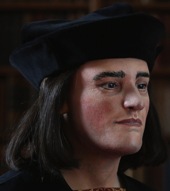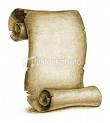 Battle of Edgecote Moor (actually Danes Moor in Northamptonshire), a battle of the Warwick Rebellion.
Battle of Edgecote Moor (actually Danes Moor in Northamptonshire), a battle of the Warwick Rebellion.
In the North, one of the captains of Richard Neville, 16th Earl of Warwick (“The Kingmaker”), calling himself Robin of Redesdale (actually a trusted Neville captain, Sir William Conyers) started a rebellion against Edward IV, which was supported by Warwick and George, Duke of Clarence, brother of Edward IV and Richard III. Edward IV was at Nottingham, where he hoped to meet up with Humphrey Stafford, Earl of Devon, and William Herbert, Earl of Pembroke.
Apparently Devon and Pembroke quarreled on the way, with Pembroke continuing on his own, encountering the rebels near Banbury. Pembroke, his brother Sir Richard Herbert as well as Richard Woodville, Earl Rivers (Elizabeth Woodville’s father), and his son John were taken prisoner and executed on Warwick’s orders without trial.
Tags: Battles, Edward IV, Nevilles
Comments Off on 26 JULY 1469
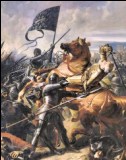 Battle of Castillon, Aquitaine, the last battle of the 100 Years’ War between the House of Valois and the House of Plantagenet for the French throne. John Talbot, 1st Earl of Shrewsbury, and father of Eleanor Talbot (Butler), is killed.
Battle of Castillon, Aquitaine, the last battle of the 100 Years’ War between the House of Valois and the House of Plantagenet for the French throne. John Talbot, 1st Earl of Shrewsbury, and father of Eleanor Talbot (Butler), is killed.
Bibliography: John Ashdown-Hill, Eleanor – The Secret Queen. The History Press, 2009 ISBN 978-0752448664 (hardback)
Illustration: The Death of John Talbot at the Battle of Castillon, by Charles-Philippe Larivière (1798-1876)
Tags: Battles
Comments Off on 17 JULY 1453
 Battle of Northampton, where John Talbot, 2nd Earl of Shrewsbury, and half-brother of Eleanor Talbot (Butler), met his death on the Lancastrian side. Yorkist victory.
Battle of Northampton, where John Talbot, 2nd Earl of Shrewsbury, and half-brother of Eleanor Talbot (Butler), met his death on the Lancastrian side. Yorkist victory.
A short description of the various battles of the Wars of the Roses can be found on the website of the Richard III Society.
Tags: Battles
Comments Off on 10 JULY 1460
 Battle of Stoke Field, Nottinghamshire, between the Yorkists on behalf of “Edward VI” and the Tudor government troops. On the Yorkist side, John de la Pole, 1st Earl of Lincoln, a nephew of both Edward IV and Richard III, was killed. He had been considered heir to the throne of Richard III after the death of Edward of Middleham. It is not quite clear who “Edward VI” actually claimed to be. According to Tudor sources he was said to pretend to be Edward, the son of George, Duke of Clarence. As the real Edward was locked up in the Tower, this was impossible. There is no surviving evidence who his own supporters said he was.
Battle of Stoke Field, Nottinghamshire, between the Yorkists on behalf of “Edward VI” and the Tudor government troops. On the Yorkist side, John de la Pole, 1st Earl of Lincoln, a nephew of both Edward IV and Richard III, was killed. He had been considered heir to the throne of Richard III after the death of Edward of Middleham. It is not quite clear who “Edward VI” actually claimed to be. According to Tudor sources he was said to pretend to be Edward, the son of George, Duke of Clarence. As the real Edward was locked up in the Tower, this was impossible. There is no surviving evidence who his own supporters said he was.
Bibliography: Smith, G, ‘Lambert Simnel and the King from Dublin’. The Ricardian, Vol. X, No.135 (December 1996) , pp. 498-536.
Tags: Battles
Comments Off on 16 JUNE 1487

Market Place in St Albans, where the first battle was fought (© D Preis)
First Battle of St Albans – fighting on the market place
On 22 May 1455 the first Battle of St Albans, Hertfordshire, between the Yorkist forces under Richard, 3rd Duke of York, and the Lancastrian forces of Henry VI under Edmund, Duke of Somerset, who fell in the battle. Henry VI was captured. The battle was won by the Yorkists.
This is the first battle in what became known as the Wars of the Roses, with the white rose standing for York and the red for Lancaster (Henry VI). This battle is unique among all the battles of the Wars of the Roses in that it was entirely fought in the streets of the town and not in a field. Walking around the market area of St Albans today, you can still see the outline of the area in medieval times with its half-timbered houses and the narrow and winding alleyways. One can’t help wondering what the town’s citizens made of this. And not to forget that not even six years later on 17 February 1461, the armies were back for a second battle.
You can read more on the first Battle of St Albans on Karen’s blog and on Dottie Tales.
A short description of the various battles of the Wars of the Roses can be found on the website of the Richard III Society.
Dorothea Preis
Tags: Battles, St Albans
 Battle of Hexham, Northumberland, the end of Lancastrian resistance (under Henry Beaufort, 3rd Duke of Somerset) to Edward IV in the north of England. The Yorkists were led by John Neville (later 1st Marquess of Montagu) and Somerset was wounded and then executed. Henry VI fled and was later found wandering helplessly around Lancashire.
Battle of Hexham, Northumberland, the end of Lancastrian resistance (under Henry Beaufort, 3rd Duke of Somerset) to Edward IV in the north of England. The Yorkists were led by John Neville (later 1st Marquess of Montagu) and Somerset was wounded and then executed. Henry VI fled and was later found wandering helplessly around Lancashire.
Tags: Battles
 Jack Cade’s Rebellion – Kentishmen revolt against King Henry VI
Jack Cade’s Rebellion – Kentishmen revolt against King Henry VI
Tags: Battles
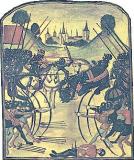 Battle of Tewkesbury, Gloucestershire, defeat of Lancastrian army, Henry VI’s son Edward killed in battle, Henry VI dies soon after.
Battle of Tewkesbury, Gloucestershire, defeat of Lancastrian army, Henry VI’s son Edward killed in battle, Henry VI dies soon after.
Illustration: The Battle of Tewkesbury from a Ghent manuscript
Tags: Battles, Edward IV, Henry VI
 Battle of Hedgeley Moor, Northumberland. The Yorkist forces were led by John Neville, 1st Marquess of Montagu (brother of Richard Neville ‘The Kingmaker’), the Lancastrians by the Duke of Somerset, supported by Sir Ralph Percy, Lords Roos and Hungerford, and Sir Ralph Grey. The Lancastrian force soon gave way and fled, except for Sir Ralph Percy, who died in the battle.
Battle of Hedgeley Moor, Northumberland. The Yorkist forces were led by John Neville, 1st Marquess of Montagu (brother of Richard Neville ‘The Kingmaker’), the Lancastrians by the Duke of Somerset, supported by Sir Ralph Percy, Lords Roos and Hungerford, and Sir Ralph Grey. The Lancastrian force soon gave way and fled, except for Sir Ralph Percy, who died in the battle.
Tags: Battles, Northumberland
Comments Off on 25 APRIL 1464
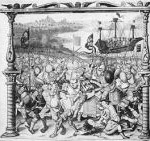 Battle of Barnet, Hertfordshire, defeat of Warwick and his brother Montagu, who both fell in the battle. Richard is said to have been in command of the vanguard.
Battle of Barnet, Hertfordshire, defeat of Warwick and his brother Montagu, who both fell in the battle. Richard is said to have been in command of the vanguard.
Read more about a possible different location for the battle here.
Tags: Barnet, Battles, Edward IV, Hertfordshire, Richard III
Comments Off on 14 APRIL 1471
 Battle of Castillon, Aquitaine, the last battle of the 100 Years’ War between the House of Valois and the House of Plantagenet for the French throne. John Talbot, 1st Earl of Shrewsbury, and father of Eleanor Talbot (Butler), is killed.
Battle of Castillon, Aquitaine, the last battle of the 100 Years’ War between the House of Valois and the House of Plantagenet for the French throne. John Talbot, 1st Earl of Shrewsbury, and father of Eleanor Talbot (Butler), is killed.



